I have a JavaFX application that uses a preloader. What I'd like to do is package it up as a native bundle (Mac app or Windows exe file that contains a copy of the Java JDK) so users who don't have the right version of Java on their computers can still run the app. I've followed Oracles instructions for creating native bundles and for adding preloaders. What I get is exactly what you'd expect—a native bundle that runs my program.
The problem is that the bundle completely ignores my preloader. It just runs the main program (after a long load time). I know the preloader is included because, when I run the jar file alone, it shows up.
Has anyone successfully bundled a JavaFX app with a preloader? Can you guide me through how to do so? I'm using Netbeans.
EDIT:
Here is the Preloader:
import javafx.application.Preloader;
import javafx.application.Preloader.ProgressNotification;
import javafx.application.Preloader.StateChangeNotification;
import javafx.scene.Scene;
import javafx.scene.control.ProgressIndicator;
import javafx.scene.image.ImageView;
import javafx.scene.layout.Pane;
import javafx.stage.Stage;
import javafx.stage.StageStyle;
public class Splash extends Preloader {
ProgressIndicator bar;
ImageView Background;
Stage stage;
private Scene createPreloaderScene() {
bar = new ProgressIndicator();
bar.setLayoutX(380);
bar.setLayoutY(250);
bar.setPrefSize(60, 60);
Background = new ImageView("Images/Splash.png");
Background.setEffect(null);
Pane p = new Pane();
p.setStyle("-fx-background-color: transparent;");
p.getChildren().addAll(Background, bar);
Scene scene = new Scene(p, 794, 587);
scene.setFill(null);
scene.getStylesheets().add(Scrap2.class.getResource("CSS/Progress.css").toExternalForm());
bar.setId("myprogress");
return scene;
}
@Override
public void start(Stage stage) throws Exception {
this.stage = stage;
stage.setScene(createPreloaderScene());
stage.initStyle(StageStyle.TRANSPARENT);
stage.show();
}
@Override
public void handleStateChangeNotification(StateChangeNotification scn) {
if (scn.getType() == StateChangeNotification.Type.BEFORE_START) {
stage.hide();
}
}
@Override
public void handleProgressNotification(ProgressNotification pn) {
bar.setProgress(pn.getProgress());
}
@Override
public void handleApplicationNotification(PreloaderNotification arg0) {
if (arg0 instanceof ProgressNotification) {
ProgressNotification pn= (ProgressNotification) arg0;
bar.setProgress(pn.getProgress());
}
}
}
And here is the first part of my main program:
@Override
public void init(){
/*Root*/
root = new Pane();
root.setStyle("-fx-background-color: transparent;");
root.setLayoutX(150);
notifyPreloader(new Preloader.ProgressNotification(0.1));
/*Create Background*/
createBinding(stage);
createContents();
createSaveMessages();
createFlipBook();
notifyPreloader(new Preloader.ProgressNotification(0.2));
/*Add Pages*/
createOverview();
createAccounts();
notifyPreloader(new Preloader.ProgressNotification(0.3));
createCounselors();
createInsurance();
notifyPreloader(new Preloader.ProgressNotification(0.4));
createAssets();
createPapers();
notifyPreloader(new Preloader.ProgressNotification(0.5));
createLoans();
createFuneral();
notifyPreloader(new Preloader.ProgressNotification(0.6));
createWills();
addAllPages();
notifyPreloader(new Preloader.ProgressNotification(0.7));
/*Add Toolbar on top*/
createToolBar();
notifyPreloader(new Preloader.ProgressNotification(0.9));
/*Create Opening Instructions*/
opening();
/*Load Saved Data*/
load();
notifyPreloader(new Preloader.ProgressNotification(1.0));
}
@Override
public void start(Stage stage) {
/*Scene*/
scene = new Scene(root, 1200, 700);
stage.setScene(scene);
scene.setFill(null);
/*Stage*/
this.stage = stage;
stage.initStyle(StageStyle.TRANSPARENT);
stage.centerOnScreen();
stage.show();
}






